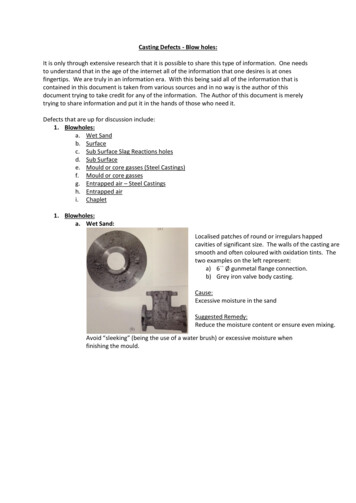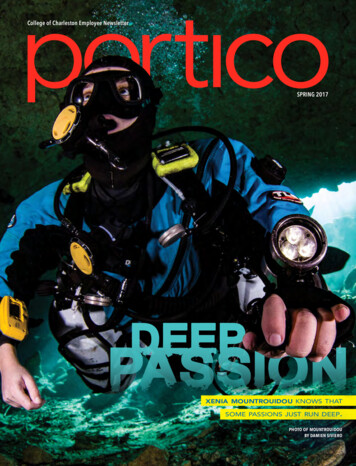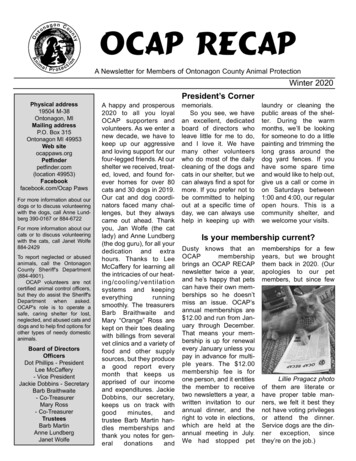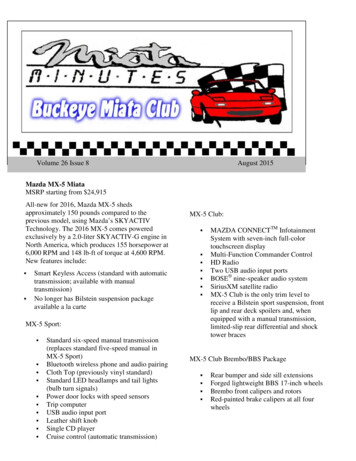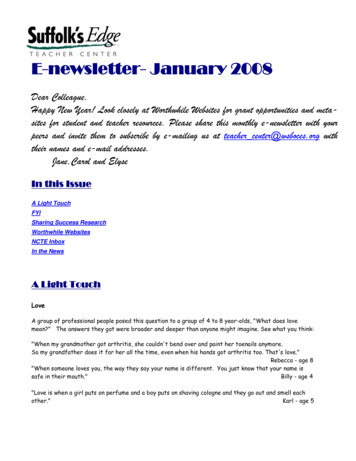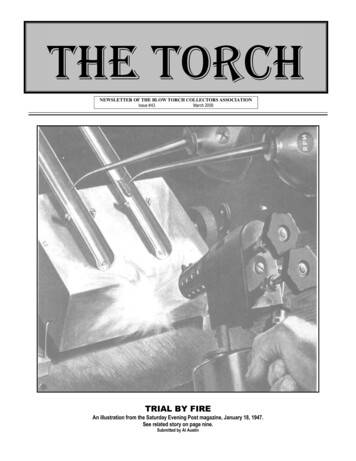
Transcription
THE TORCHNEWSLETTER OF THE BLOW TORCH COLLECTORS ASSOCIATIONIssue #43March 2009TRIAL BY FIREAn illustration from the Saturday Evening Post magazine, January 18, 1947.See related story on page nine.Submitted by Al Austin
NEW MEMBERSBob Fritz, Joppa, Maryland, recently became a new member thanks to his dad and BTCAmember, Wendel Fritz.David Gaines, Saint Albans, West Virginia, is a ten-year collector with just over 100 torches inhis collection and all are restored and prominently displayed in his home.Charles Johnson, Eatontown, New Jersey, joined BTCA after recently purchasing theVINTAGE BLOWTORCHES book on eBay.Stan Olsen, Yorkton, Saskatchewan, Canada is a long-time collector with over 60 torches inhis collection. Like many of us .Stan thought that he was the only torch collector in the world!He occasionally purchases torches on eBay, and when he and his wife winter in Yuma, Arizona,he peruses the antique stores and flea markets for torch bargains. Stan purchased theVINTAGE BLOWTORCHES book on eBay and joined BTCA at the same time.Wayne Poapst, Merrickville, Ontario, Canada, is a six-year collector with over 200 blowtorches, and 145 are all different types from six different countries. The 145 torches are allrestored and displayed on shelves for anyone to view. See Wayne’s story in a follow up article.James Smith, Chipley, Florida is a thirty-year torch collector! He and his wife Pat own andoperate the High Plumbing Company in Chipley so James is very familiar with blow torches.He discovered our group thanks to BTCA member George Husen.WELCOME ABOARD! NOTES FROM ALL OVER Al Austin was cleaning up his shop, and among thetreasures that he uncovered included several magazinesand sales catalogs dating back to the 1930s and 1940s.While looking through the literature, he can across a fewtorch-related articles, and decided to make copies and sentthem in to us. One article in particular caught our eye,TRIAL BY FIRE from a 1947 Saturday Evening Postmagazine .see the related story in this issue about thisinteresting topic.Al also sent in a photo of his three-star rated rareShapleigh Hardware Co., Shapleigh Norleigh one-quarttorch. It has the Diamond Brass logo plate and horizontalair pump assembly. Issue #43, March 2009THE TORCH2
HELP .WE NEED YOUR INPUT. Wayne Poapst,a new BTCA member, has been in the layout designand printing business for twenty years, and he advisedthat using the whole width of 8.5 inches in a singlecolumn layout is a no-no since the human eye does notreach that far without having to move, and the readerwill lose the return to the left side to pick up the nextword. According to Wayne’s experience, having twocolumns is the way to go.You all have noticed that we’ve gravitated from threecolumns to two columns, and recently to one columnand a combination of one and two columns in ournewsletter layout. We’re certainly not professionallayout people and just did what looked good or wasconvenient. Based on Wayne’s comments, it makes uswonder if we should revert back to a two column layoutor a combination.We would like to hear from our readers on theirreading experiences with our different layouts and yourpreferences; one column, two columns, or acombination of one and two columns. This newsletter isbeing published using a one/two column combination.We aim to please, so please let us know yourpreference for future newsletters.Charles Smith recently purchased this Walltorch on eBay. What’s so unusual is that itappears to be chrome plated the entire torchis plated! The plating is very poor so it may nothave been a production model. Does anyoneelse own a plated Wall torch?Wendel Fritz sent in some great photos .one in particular caught our attention, it was aphoto of the same greenhouse building that housed the 11 th Annual BTCA convention on hisproperty in Joppa, Maryland. What’s so unusual about the photo is that the greenhouse is filledwith red and white Christmas poinsettias! We would have posted the photo, but a black andwhite photo of colorful poinsettias would not do it justice. Instead we’ll print a photo of one ofWendel’s torches, an Otto Bernz No. 50 Painter’s Flat Burner Blow Torch.This is one of the few painters’ torches produced by theOtto Bernz Co. that featured a rectangular-shaped horizontalburner head nozzle. According to a Bernz advertisement,the torch could also be provided with a burner assembly inthe vertical position. Many torch manufacturers provided apaint burner attachment that would fit over most roundburner nozzles actually Bernz also produced that sameattachment; however Bernz also produced this dedicated No.50 Painters’ Blow Torch. EDITOR’S NOTE: We really appreciate all of the emails,letters, and photos that members continually send in toBTCA. We try our best to print the information submittedand include accompanying photos; however, due to photoquality or limited space, we sometimes cannot printeverything that is submitted. Remember, WHITE or VERYLIGHT SOLID COLORED backgrounds for the photos, andget as close as possible. Also, please include dimensionsand any identifying information. Thanks for your support.Issue #43, March 2009THE TORCH3
Jim Minton sent in a great photo of his Hanau Dental torch. Both the torch and the boxlook to be in excellent condition. Also, Jim is restoring a 1948 Ford Coupe but no photo. Jim,how about a photo of the Coupe when it is finished? Keith Mahaffey sent in a note with his dues payment describing a blow torch he recentlypurchased. It is stamped with FARWELL OZMUN KIRK & CO., ST. PAUL. Now, that is aname we’ve never heard before! Keith followed upwith photos of a quart-size blow torch that wesuspect was manufactured by the Geo. Diener Mfg.Co. and brand labeled for Farwell, Ozmun, Kirk &Co.The fuel control knob and the air pumpconfiguration are typical of the Diener Co., althoughthe handle looks more like a Clayton & Lamberttorch. We will be adding this name and photo tothe upcoming supplement.Issue #43, March 2009THE TORCH4
For those of you that collect firepots, here’s a behemoththat you should have in your collection! Bob Scheidermansent in a Clayton & Lambert firepot and blow torch catalog Ddated January 1930. Included in the literature were a fewfirepots not seen before that will be added to the blow torchbook supplement.In particular is the No. 75 firepot a real behemoth!Unfortunately there are no dimensions listed in the catalog,however, one can only imagine its size considering that it caneasily and quickly melt 100 pounds of solder! It also featuredan easily replaceable burner unit that could be changed out ina mere forty five seconds! It could also burn either gasoline orkerosene simply by changing out the burner orifice one eachwas supplied with the firepot. It had a fuel capacity of onegallon, weighed in at 20 pounds without fuel, and had a listprice of 50 and that was in 1930 dollars!We heard from Metro Roark he just purchased some buffing equipment and has restoredabout fifty torches. Unfortunately his wife Linda will only allow him to keep about fifteen torchesin the house. Linda, you have to understand how important it is to be able to display one’srestoration efforts, so cut Metro some slack and up that number a bit!We could not resist printing this ad for a Thompson submachine gun that Charles Smithfound during his torch research in the various trade magazines. The article is from theHardware Dealer's Magazine, volume 55, number 328, dated April, 1921. You’ll note in thearticle that the submachine gun “can be carried under one’s coat ready for instant use”.Issue #43, March 2009THE TORCH5
Max Rhodes acquired this interestinglooking blow torch. It appears to have beenmanufactured by the Wall Mfg. Co. Thehandle has cast into it the initials “GMPC”,with no other identifying marks or numbers.He purchased the item from Germany, soit is possible that it was manufactured for theUS military.Does anyone have anyinformation on GMPC or a similar type oftorch?Chris Mello emailed in numerous photos of some of his favorite torches. One in particularis an Otto Bernz No. 13 Self-Blowing Alcohol Torch as seen below on the left. It is somewhatunusual to see a complete torch including the windscreen, screw-on nozzle cap the preventedfuel evaporation, and the wood handle.Chris also emailed a great photo of a new never used W. B. Marvin Mfg. Co. No. 20Soldering Torch as seen below on the right. It’s a real bonus when you can find a new andunused torch with the original box. It certainly adds to the value of an item and at timesprovides additional information about the item.Issue #43, March 2009THE TORCH6
Jim Janke sent in a photo of one of his blow torchesmanufactured by the Unique Mfg. Co. It has to be thebrightest red we’ve ever seen, and unfortunately this blackand white photo does not do it justice. Trust us .it isbright red! Dave Schulte emailed photos of an interesting itemmanufactured by the Quick Meal Stove Co. which was adivision of the American Stove Co. Quick Meal did producea small line of paint burner blow torches and soldering ironfurnaces.We’re not really sure what Dave’s item really is. It’smade entirely of brass except for the drip cups; the fueltank is approximately six inches in diameter and 4.5 inches tall. Dave guesses at a fuelcapacity of 1.5 - 2 quarts. There are no valves for fuel or flame adjustments, only an air pumpand a missing pressure relief valve. It’s possible that it is the bottom portion of a soldering ironfurnace, or it could also be part of a cooking stove since the company certainly produced ahuge variety of cooking devices. Ron Johnson Jr. submitted some interestinginformation on the Hanau Dental blow torch. Ifyou have the VINTAGE BLOWTORCHES bookand read the history of the Hanau torch, you’llremember that the Hanau Bakelite torchcontinues to be manufactured and marketedtoday by Water Pik Technologies, successor toHanau Engineering Co. by a succession ofacquisitions including Teledyne Inc. Ron has aHanau torch and the original box with TeledyneInc. as the manufacturer. The box lists thecompany as TELEDYNE HANAU and located inBuffalo, New York. The box is dated November,1982. Issue #43, March 2009THE TORCH7
HOW I STARTED COLLECTING TORCHESBy Wayne PoapstI have been an auctioneer since 1978, and for the past 20 years I have been a backupfor another auctioneer. Back in 2002, while working at an auction as backup, I was holding upfive very dirty, oily, grimly-looking blow torches. We couldn’t get any bids from theaudience so I offered five dollars .and the auctioneer said SOLD! When I got home, I foundthat they were five different torches and those were the first torches that started my collection.I grew up on a farm and dad always had a blow torch, so I have some fond memories ofhim using his torch. I started doing some torch research, however, the only information that Icould find in print was the book authored by Dick Sarpolus. I did finally find and purchase theVINTAGE BLOWTORCHES book. Since purchasing the reference book I have bid on andbought at least twenty torches on eBay. I lost two to other bidders for over 300, and knewthey were very rare based on the book’s rarity rating section .so the book has been veryhelpful to me.I attend up to nine shows each year at various fairs, antique shows, and museumswhere I display my torches and torch related materials. I own a metal trailer with eight foot longmetal racks that hold approximately 75 torches.Since I know a lot of antique dealers, they all keep their eyes open for torches for meand other auctioneers also help me locate torches. In addition to my 200 torches, I also havean assortment of soldering irons, a few firepots, a few cast iron tractor seats, and I used tocollect “hit ‘n miss” engines. 5 YEAR ANNIVERSARYThe following members are celebrating their 5th anniversary as members of BTCA.Congratulations on your first five years and thank you for your continued support of ourorganization!Rick BealsMalcolm FrancisJack CrooksMartin FrenchJean Claude De Marteleire Leslie LeeRudy DokterJimmie MayesMalcolm ForsterGerald Watson10 YEAR ANNIVERSARYA special thank you goes out to the following 26 members that joined BTCA ten years ago!Many thanks for your long term support of our organization!Tom BartlettStefan BergHoward DeRosaJohn DorffeldClarence GoldbergLeroy GoodwinClyde HalseyBilly HartOrthun HereimJohn HoffmanTom HolderAllan HoughtonDonald HuntingtonIssue #43, March 2009THE TORCHJim JankeWilliam KitazakiBobby LesterLee MillerBob ScheidermanHilton ShackleyTom SmithRobert SpearMel StoddardAndy StrattonVicky TeetersMerlin VandenplasDave Weaver8
TRIAL BY FIRESubmitted by Al AustinAl uncovered this article in a January 18, 1947 Saturday Evening Post magazine. It is anadvertisement for RPM motor oil. The illustration depicts a dramatic blow torch test demonstrating how“old-style” oil runs away from heat while compounded RPM oil stays put. The article reads: “This picturecouldn’t have been made a few short years ago. In this blistering blast of blow torch heat, you see theRPM compounded motor oil disproving the old theory that oil runs from heat. The secret of RPM’s abilityto withstand searing temperatures, such as this blow torch demonstration, is a new compound perfectedin Standard of California Laboratories. This demonstration shows how uncompounded oil, on the left,actually runs uphill to escape heat while the compounded RPM oil, on the right, stays put in the trough.In upper cylinders of modern automobiles, where flame temperatures soar to 3600 degrees F,uncompounded oils often leave bare spots exposed to metal-to-metal wear. RPM compounded oil sticksto these hot spots, cuts down on wear and repair bills, and stretches engine life.”The article stated that RPM compounded oilwas 100% pure paraffin based, and laboratorytesting results indicated that engines utilizing RPMcompounded oil wore 30% less than conventionaloiled engines. The RPM oil was sold on the eastcoast through Calso gas stations, and on the westcoast at Chevron and Standard gas stations.Today, ChevronTexaco Products Companycontinues to produce a complete line of RPMlubricants for a variety of gasoline and dieselengines.We’re a bit reluctant to positively identifythe blow torch used in the laboratory testing. Manyof the characteristics reflect a Clayton & Lamberttorch possibly a No. 308 with a windscreen. However, we’re perplexed about the fuel cap on the topleft of the fuel tank. It is an illustration, so the artist may have added his own ideas on what a blow torchshould look like. DO YOU HAVE A LENK HOOK?Actually, it is a soldering iron hook or support for asmall Lenk gasoline torch. Charles Smith acquired thetorch with the soldering iron hook attached to the torch.Both the wire hook and front burner notched piece aremade of steel, although the front burner piece appears tobe copper plated.The torch in the photo is a Lenk No. 104, a ¾ pintgasoline model illustrated on page 275 of the VINTAGEBLOWTORCHES book, although the soldering-ironattachments would certainly fit on many other Lenkmodels. We do not know whether the attachments weredistributed by Lenk or are hand-made items to suit theneeds of its original owner. Does anyone else have thesame attachments on their Lenk torch?Issue #43, March 2009THE TORCH9
WHITE MFG. CO.JUNIOR LOOK-ALIKEIn the late 1800s, Clayton & Lambert manufactured a No. 4 Junior blow torch, with avery unusual and small cone-shaped fuel tank, see VINTAGE BLOWTORCHES book, page112. From what information we have on the No. 4 Junior, it appears that C&L only producedthe torch from about 1897 to around 1900. After 1900, C&L does not even offer replacementparts for the No. 4 Junior torch in any of their torch and parts catalogs, so we suspect that theyonly produced a limited quantity and for a very short period of time.We know that a few members own No. 4’s, and Mike Thornhill actually displayed oneat the 7th Annual BTCA Convention in Las Vegas so a few have survived.We’re leading up to the fact that the White Mfg. Co. also produced the same torch. Werecently learned this since Charles Smith and Wendel Fritz each sent in photos of their WhiteJunior look-alike torches and they are nearly identical to the C&L Junior torch. Who copiedwho .that is the question.The informationon the brass label ofWendel’s torch isstamped “PATENTPENDING”, and thereferencedpatentwas issued on June29, 1897. The first known mention of the C&L Juniortorch was in a tool advertisement dated 1897. Thepatent date on Charles’ White torch references a June29, 1897 date, however, the application for the patentwas made on April 20, 1896 ten months prior to thepatent award date. Referring to Wendel’s torch, theinformation on his brass label indicates “PATENTPENDING”, which says that White was producing thetorch sometime before the June, 1897 date. There istoo much of a coincidence in the timing to think that each company came up with the samedesign and appearance so the question is, again, who copied who.What’s really ironic is that the illustration in the White patent has no resemblancewhatsoever with either the C&L Junior or the White Junior look-alike although Charlesdiscovered that the White patent, number 585,641, is referenced on many of his other Whitetorches that are not the Junior style. Another ironic point is that we have some White Mfg. Co.literature dating back to 1894, yet there is no reference to the Junior look-alike.Issue #43, March 2009THE TORCH10
The White Company did not assign numbers to their torches, but rather gave themnames; i.e. TEMPEST, FIRE FLY, TERROR, etc., but since we’ve never seen this particulartorch listed in any White literature, there is no way to determine its name perhaps they wouldhave named it JUNIOR.The Smith torch and Fritz torchvary somewhat in theburnerassemblydesign, but since theFritztorchwasmanufactured muchearlierthantheSmith torch, perhapsWhite changed to adifferentburnerdesign after the patent was issued. One way to determinethis is for BTCA members to check their collections for aWhite Junior look-alike and send in your photos of the torchand the label information. Maybe we can solve the mysteryof which burner design is the correct one. A.E. LOVETTBy Charles SmithI recently acquired an A.E. Lovetttorch with a horizontal burner thatis not listed in the VINTAGEBLOWTORCHES book. It was reallydirty when I got it but the magic fluidand Evapo-Rust worked wonders! Ialso have the vertical "twin" which isshown on page 285 of the book.The copper tank, fill and pumpassemblies, handle and strap-handlesupport, and drip cup are identicalbetween the two, including the size ofeach component. Even the burner isidentical in all aspects, includingdimensions, except for the horizontalrather than vertical female mountingscrew. I have to presume that thebrass wind screen was supplied onlywith the horizontal torches. My verticaltorch has none, and Lloyd's verticaltorch that is shown on page 285 of thebook also has no wind screen.Issue #43, March 2009THE TORCH11
Interestingly, the "Lovett Barthel" torches shown in the middle left part of page 285 agreewith this observation. I must admit that both of my copper-tank Lovett torches are indeedbeautiful! BLOWTORCH CAUSES HOUSE FIRESubmitted by Charles SmithIn the last newsletter, it was an article about getting rid of cobwebs. This time thetorch was used in melting ice. Will they never learn?Fire officials in New Bedford, Mass., said that a man using a blowtorch to meltice on his back porch ended up setting his house on fire, causing up to 30,000 indamage.Fire Capt. Scott Kruger told reporters that no one was injured during theincident at the three-story home. Kruger says the man was using a blowtorchhooked up to a twenty-pound propane cylinder. He got too close to the building'swood frame and ignited the vinyl siding. The fire quickly spread into the bu
operate the High Plumbing Company in Chipley so James is very familiar with blow torches. . Jim Janke sent in a photo of one of his blow torches manufactured by the Unique Mfg. Co. . Dave guesses at a fuel capacity of 1.5 - 2 quarts. There are
